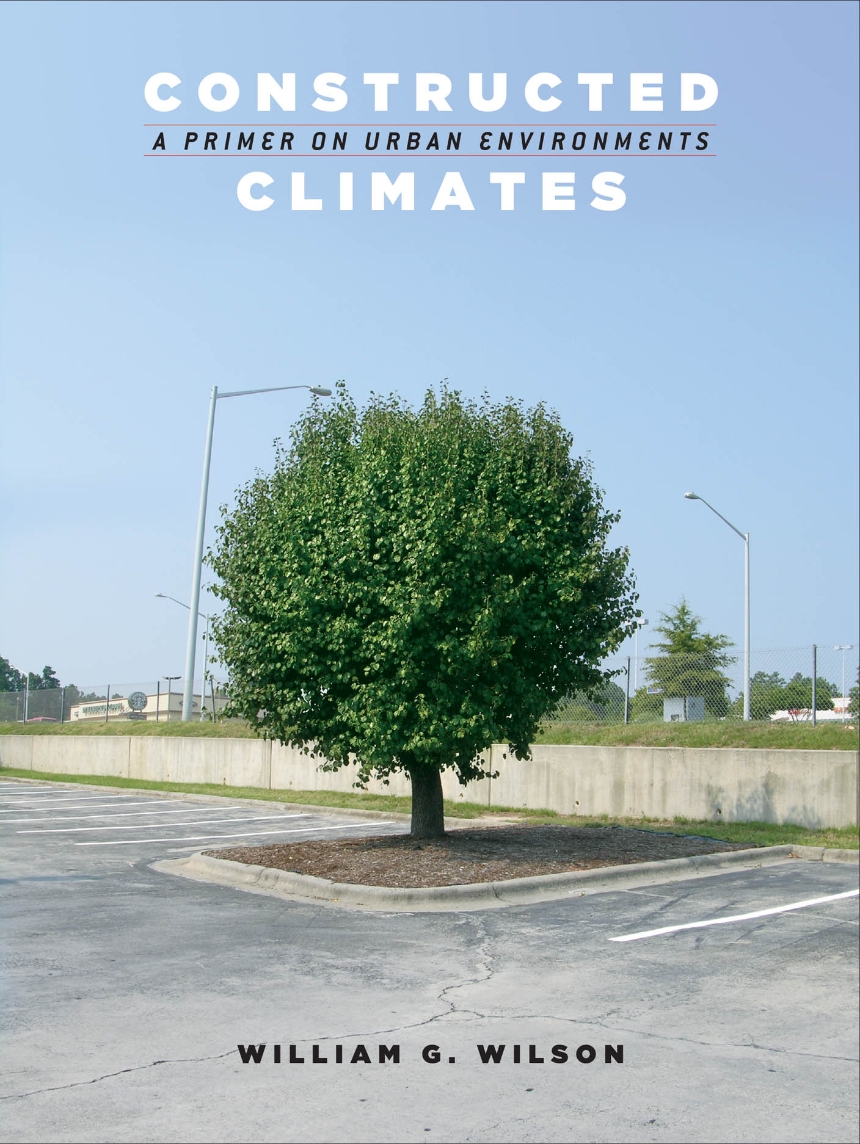Constructed Climates
A Primer on Urban Environments
As our world becomes increasingly urbanized, an understanding of the context, mechanisms, and consequences of city and suburban environments becomes more critical. Without a sense of what open spaces such as parks and gardens contribute, it’s difficult to argue for their creation and maintenance: in the face of schools needing resources, roads and sewers needing maintenance, and people suffering at the hands of others, why should cities and counties spend scarce dollars planting trees and preserving parks?
In Constructed Climates, ecologist William G. Wilson demonstrates the value of urban green. Focusing specifically on the role of vegetation and trees, Wilson shows the costs and benefits reaped from urban open spaces, from cooler temperatures to better quality ground water—and why it all matters. While Constructed Climates is a work of science, it does not ignore the social component. Wilson looks at low-income areas that have poor vegetation, and shows how enhancing these areas through the planting of community gardens and trees can alleviate social ills. This book will be essential reading for environmentalists and anyone making decisions for the nature and well-being of our cities and citizens.
288 pages | 31 halftones, 56 tables | 6 x 8 | © 2011
Biological Sciences: Botany, Ecology, Natural History
Earth Sciences: Environment
Reviews
Table of Contents
1 Cities and Nature
Human population increased sixfold over the last century
Water, warmth, and light make plants grow
High evapotranspiration promotes biodiversity
Humans exceed the natural population density for their body size
The last century brought increased agricultural efficiency
Fossil-fuel-based nitrogen production increased crop yields
Urban land use grew as small farms disappeared
Cities change ecological communities
Agricultural and urban land use reduce streamwater quality
Impervious surfaces in urbanized watersheds hurt organisms
Durham rainfall exceeds regulated basin sizes
Reservoirs reduce sediments while providing water
2 Shading and Cooling in City Climates
Low vegetation correlates with high temperature in Durham
Low vegetation correlates with high temperature in Indianapolis
Low temperature correlates with high vegetation
Urban heat islands spawn thunderstorms
Cities change rainfall patterns
Lightning strikes reflect urban weather changes
Cities grow warmer
Closed-in urban areas have higher heat islands
The urban heat island may be weak while Earth warms
Equal heat contained in air, a sprinkling of water, and an asphalt road
Whiter surfaces are cooler
Parking lot trees could provide shade
Big trees could provide lots of shade
Bigger and younger trees transpire more water
Trees near asphalt stop transpiring early in the day
Evapotranspiration is high from watersheds and lawns
New developments can plan for shade
Paving and grass can be combined
3 Energy Use and Carbon Budgets
U.S. energy sources have changed
States vary in their gasoline and electricity use
Per capita energy use depends on a state’s population density
Economic productivity correlates with energy use
Photosynthesis links carbon, water, nitrogen, and sunlight
Atmospheric CO2 increased with human emissions
Global warming changes nature
Species have different features in urban and rural environments
Soils contribute to carbon budgets
Vegetation stores and sequesters carbon
Urban pruning can be very intensive
Carbon costs of landscaping machines are high
Durham citizens export their carbon sequestration
Trees and white paint reduce energy consumption
Trees help small houses keep cool and break even for heating
Wood has low energy content
Durham citizens use more energy than local forests can provide
4 Emissions and Urban Air
Human sources of volatile organic compounds (VOCs) are high
Fossil-fuel use produces many pollutants
Trees produce VOCs
VOCs produced by trees vary across the contiguous United States
Trees produce more VOCs in bright light and high heat
VOC sources vary in place and time
VOCs, reactive nitrogen, and sunlight lead to ground-level ozone
Large pollution inputs lead to high downwind ozone levels later
Ozone production and levels have a complicated emissions dependence
High ozone levels seenWednesday through Saturday, March through September
Ozone in rural areas increases with temperature and nitrogen
When it’s hot, urban ozone levels exceed regulatory allowances
High ozone levels harm vegetation
Air pollution varies greatly in space and time
5 Social Aspects of Urban Nature
What’s the value of Chickpea?
S.A. Forbes (1880) estimates the value of birds
Trees make satisfying neighborhoods
People like neat trees, not messy forests
Park features involving scenic beauty and perceived security
Underbrush was bad as far back as 1285
About 10 out of 10 people prefer malls
Varying tree cover in Chicago public housing
Reduced vegetation correlates with higher crime
Girls’ self-discipline develops better with nature
Nature promotes emotional and physical health
Trees promote bird and plant species richness
6 Human Health and Urban Inequities
Heat waves lead to deaths a few days later
Particulate matter is bad for older people
High ozone and SO2 levels predict high asthma hospitalizations
Asthma incidence and pollution aren’t tightly correlated through time
Though cities differ, heat kills people in July and August
Air conditioning reduces heat-related mortality
Many people die in winter (accounting for age, race, and gender)
Lower income, fewer trees, and higher temperatures go together in Durham
Wealth, homeownership, and trees connect in Milwaukee, Wisconsin
Wealth, education, and vegetation correlate in Baltimore, Maryland
Parks, trees, and plants come with wealth
Minority populations have worse air, income, and asthma
Healthier neighborhoods are usually wealthier neighborhoods
Income helps education and increases life expectancy
7 Summary and Implications
Appendix: Graphical Intuitions
Three equivalent data representations
Graphing visual correlations
Importance versus significance
Plotting transformed data
Quantities covary
Sample sizes and measures of variation
Notes
References
Index
